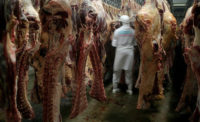On May 1, the Food Safety and Inspection Service (FSIS) began the next phase of its nationwide Raw Pork Products Exploratory Sampling Project (RPPESP). The purpose of the project is to determine the prevalence of pathogens in pork and use this data to “inform food safety policies.”
FSIS initiated the first phase of the RPPESP in May 2015. During this phase, the agency analyzed all samples collected for Salmonella and indicator organisms and analyzed a subset of samples for Shiga toxin-producing E. Coli (STEC). After collecting an initial 1,200 samples, the agency extended sampling for an additional interim period. Based on data collected thus far, FSIS has decided to analyze all pork samples for STEC in addition to Salmonella and indicator organisms.
The agency issued a notice on March 31 providing inspection program personnel (IPP) new instructions for the next phase of the RPPESP. In addition to notifying IPP that all samples will be tested for STEC, the notice indicates FSIS made changes to the sampling scheduling method. During the initial phase, establishments were exempt from sampling if the average daily volume range of eligible pork products was 1 to 1,000 pounds per day for an eligible product group. During the new phase, establishments producing an average daily volume less than 100 pounds are exempt, but establishments producing 101 to 1,000 pounds a day are eligible for sampling if the number of days of production is 21 or more in the calendar month. IPP will now receive sampling tasks in PHIS based not only on the product groups listed in the establishment profile and the average daily production volumes, but also on the number of days produced, for the eligible product groups.
The notice also indicates the agency has revised the product group definitions for eligible pork products so IPP can better determine which products are eligible for sampling. This includes new definitions for eligible raw intact and non-intact pork cuts and raw comminuted pork products. Importantly, the following pork products continue to be exempt from sampling: 1) battered and breaded products; 2) not ready-to-eat (RTE) products in the HACCP processing category “Heat-treated not Fully Cooked – Not Shelf Stable”; and 3) raw pork products intended for use in RTE product at another federally inspected establishment.
IPP are to continue to notify establishment management prior to collecting samples. They are also to notify establishment management of results, at the time of receipt as well as in Quarterly Establishment Information Letters. However, because neither Salmonella nor STECs are considered adulterants in pork, IPP are to advise establishments that individual sample results will not result in regulatory actions and establishments need not hold products pending results.
Many establishments have questioned whether it would still be prudent to hold product pending test results now the agency has expanded its sampling program to include STEC. The concern is that if an outbreak occurs, the establishment would be in “legal jeopardy” if it were shown that it was aware of a pathogenic result but did not take action to remove product from commerce.
Although each establishment must decide for itself whether it is prudent and feasible to hold product pending results from the RPPESP, establishments may consider the following factors in making this decision. First, what is the risk of a STEC outbreak, compared to the risk of a Salmonella outbreak, associated with raw pork? Although both are pathogens, we are not aware of any establishments that hold pork products pending Salmonella results. While there have been Salmonella outbreaks associated with pork, we are not aware of any outbreaks associated with STEC in pork. Second, if an establishment were to decide to hold product, they would need to clearly define the “lot” that would be implicated by a positive result. Through robust sampling and lotting programs, raw beef establishments are able to limit the lot or lots implicated by a positive STEC result. Without such data, it may be difficult for a pork establishment to define the implicated lot and support microbiological independence of finished product produced from the same production lot of source materials.
Regardless of whether an establishment decides to hold product pending results, establishments should consider any pathogen results from the RPPESP in assessing their food safety procedures and improving operations. Perhaps that is the best way to minimize legal risks. NP








